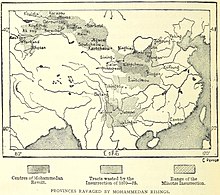
Back تمرد بانثاي Arabic Revolta Panthay Catalan Panthay-Rebellion German Rebelión de los panthay Spanish Révolte des Panthay French Pemberontakan Panthay ID パンゼーの乱 Japanese Pemberontakan Panthay Malay Panthayopprøret NB Revolta dos Panthay Portuguese
| Panthay Rebellion | |||||||
|---|---|---|---|---|---|---|---|
 Map of the Muslim Uprisings against the Qing Empire | |||||||
| |||||||
| Belligerents | |||||||
|
|
| ||||||
| Commanders and leaders | |||||||
|
Cen Yuying Ma Rulong |
Du Wenxiu Ma Shenglin † Ma Shilin | ||||||
| Strength | |||||||
| Manchu, Han Chinese, and Loyalist Muslim troops | Rebel Muslims, Rebel Han Chinese and Muslim ethnic minorities | ||||||
| Casualties and losses | |||||||
| 1,000,000 dead | 1,000,000 (including Muslim and non-Muslim civilians and soldiers) | ||||||
| Panthay Rebellion | |||||||||
|---|---|---|---|---|---|---|---|---|---|
| Traditional Chinese | 杜文秀起義 | ||||||||
| Simplified Chinese | 杜文秀起义 | ||||||||
| Literal meaning | Du Wenxiu uprising | ||||||||
| |||||||||
| Alternative Chinese name | |||||||||
| Traditional Chinese | 雲南回變 | ||||||||
| Simplified Chinese | 云南回变 | ||||||||
| Literal meaning | Yunnan Hui rebellion | ||||||||
| |||||||||
The Panthay Rebellion (1856–1873), also known as the Du Wenxiu Rebellion (Tu Wen-hsiu Rebellion), was a rebellion of the Muslim Hui people and other (Muslim as well as non-Muslim) ethnic groups against the Manchu-led Qing dynasty in southwestern Yunnan Province, as part of a wave of Hui-led multi-ethnic unrest.
The name "Panthay" is a Burmese word, which is said to be identical with the Shan word Pang hse.[1] It was the name by which the Burmese called the Chinese Muslims who came with caravans to Burma from the Chinese province of Yunnan. The name was not used or known in Yunnan itself.[2] The rebellion referred to itself as the Pingnan Kingdom, meaning Pacified Southern Kingdom.[3]
- ^ Scott 1900, p. 607
- ^ Yule & Burnell 1968, p. 669
- ^ Notar, Beth (2001). "Du Wenxiu and the Politics of the Muslim Past". Twentieth-Century China. 26 (2): 64–94. doi:10.1179/tcc.2001.26.2.64. S2CID 145702898.